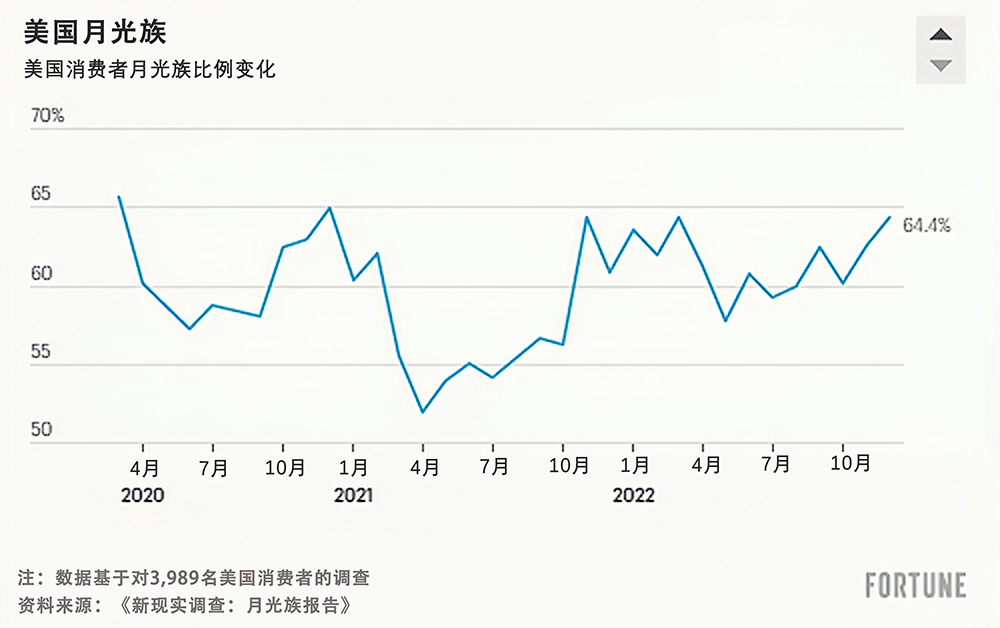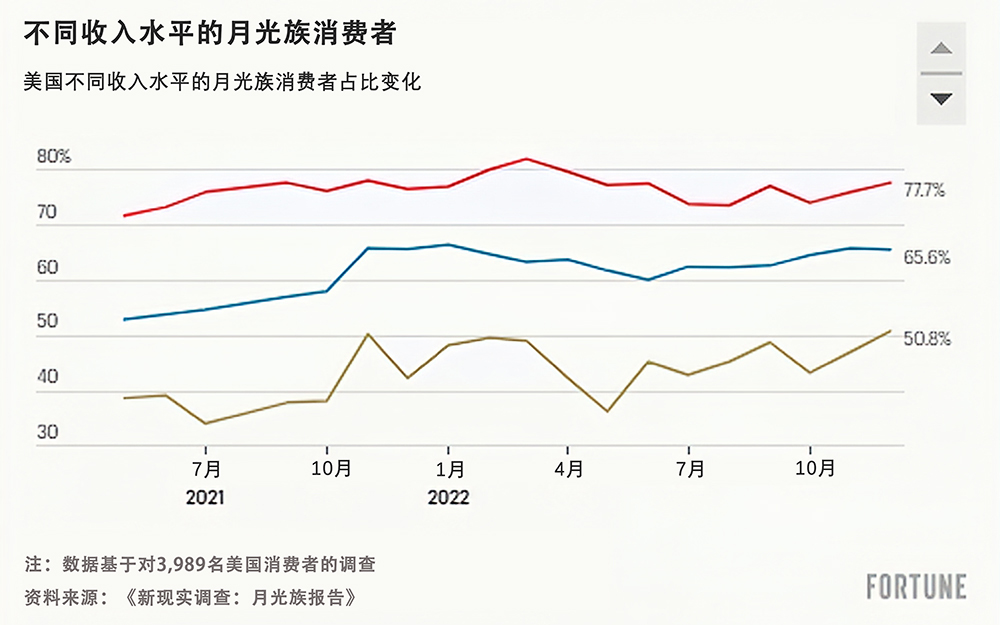
美國(guó)月光族的人數(shù)幾乎達(dá)到了疫情初期,、封控、停業(yè)和大眾恐慌期間的最高水平,。
PYMNTS的最新版《新現(xiàn)實(shí)調(diào)查:月光族報(bào)告》(New Reality Check: The Paycheck-to-Paycheck Report)顯示,,2022年12月,約64.4%(1.66億)的美國(guó)成年人表示,每到月底就會(huì)分文不剩,,略低于2020年3月65.7%的月光族比例,。

2021年底也有約930萬(wàn)月光族。但這一次,,高收入者也未能幸免:新增的約800萬(wàn)勉強(qiáng)維持生計(jì)的美國(guó)人來(lái)自高收入階層,。PYMNTS的調(diào)查顯示,12月,,約50.8%收入超過(guò)10萬(wàn)美元的美國(guó)人表示自己是月光族,。
去年12月,美國(guó)高收入月光族的數(shù)量,,較2021年12月的42%增長(zhǎng)了9個(gè)百分點(diǎn),。相比之下,去年,,美國(guó)中低收入月光族的比例相對(duì)穩(wěn)定,。

報(bào)告發(fā)現(xiàn):“然而,隨著物價(jià)持續(xù)上漲削弱人們的購(gòu)買力,,越來(lái)越多消費(fèi)者發(fā)現(xiàn)更難償還每個(gè)月的債務(wù),。高收入消費(fèi)者也感到捉襟見肘,去年有越來(lái)越多收入者變成了月光族,?!?/p>
為什么現(xiàn)在美國(guó)高收入群體處境更艱難?持續(xù)高通脹肯定是原因之一,,但近在眼前的經(jīng)濟(jì)衰退,、高利率、金融市場(chǎng)波動(dòng)和白領(lǐng)裁員,,也對(duì)高收入者產(chǎn)生了影響,。
在通脹方面,據(jù)蓋洛普(Gallup)9月發(fā)布的調(diào)查報(bào)告顯示,,大部分美國(guó)人(56%)表示,,物價(jià)上漲加劇了家庭的財(cái)務(wù)困難。在經(jīng)濟(jì)周期早期,,通脹上漲問(wèn)題主要集中在燃料和二手車價(jià)格方面,。這對(duì)于黑人、拉丁裔和中產(chǎn)家庭的影響更大,。
例如,,紐約聯(lián)邦儲(chǔ)備銀行(Federal Reserve Bank of New York)的研究顯示,2021年,,美國(guó)中產(chǎn)階層面臨的通脹率最高,,主要是因?yàn)榻煌ǔ杀旧蠞q。但隨著通貨膨脹向其他行業(yè)蔓延并產(chǎn)生更大影響,包括食品和消費(fèi)品等,,通脹對(duì)中產(chǎn)家庭產(chǎn)生的過(guò)大影響也有所減少,。
PYMNTS研究發(fā)現(xiàn),盡管美國(guó)勉強(qiáng)維持生計(jì)的人數(shù)眾多,,但消費(fèi)者對(duì)今年的財(cái)務(wù)前景持相當(dāng)樂觀的態(tài)度,。約40%的美國(guó)月光族預(yù)計(jì)2023年,其收入能夠追上通脹,,原因包括加薪和額外收入來(lái)源等,。
同樣有約40%的美國(guó)人預(yù)計(jì)今年個(gè)人財(cái)務(wù)狀況會(huì)有所好轉(zhuǎn),比2022年7月33%的樂觀者占比提高了7個(gè)百分點(diǎn),。(財(cái)富中文網(wǎng))
翻譯:劉進(jìn)龍
審校:汪皓
美國(guó)月光族的人數(shù)幾乎達(dá)到了疫情初期,、封控、停業(yè)和大眾恐慌期間的最高水平,。
PYMNTS的最新版《新現(xiàn)實(shí)調(diào)查:月光族報(bào)告》(New Reality Check: The Paycheck-to-Paycheck Report)顯示,,2022年12月,約64.4%(1.66億)的美國(guó)成年人表示,,每到月底就會(huì)分文不剩,,略低于2020年3月65.7%的月光族比例。
2021年底也有約930萬(wàn)月光族,。但這一次,,高收入者也未能幸免:新增的約800萬(wàn)勉強(qiáng)維持生計(jì)的美國(guó)人來(lái)自高收入階層。PYMNTS的調(diào)查顯示,,12月,,約50.8%收入超過(guò)10萬(wàn)美元的美國(guó)人表示自己是月光族。
去年12月,,美國(guó)高收入月光族的數(shù)量,,較2021年12月的42%增長(zhǎng)了9個(gè)百分點(diǎn)。相比之下,,去年,美國(guó)中低收入月光族的比例相對(duì)穩(wěn)定,。
報(bào)告發(fā)現(xiàn):“然而,,隨著物價(jià)持續(xù)上漲削弱人們的購(gòu)買力,越來(lái)越多消費(fèi)者發(fā)現(xiàn)更難償還每個(gè)月的債務(wù),。高收入消費(fèi)者也感到捉襟見肘,,去年有越來(lái)越多收入者變成了月光族?!?/p>
為什么現(xiàn)在美國(guó)高收入群體處境更艱難,?持續(xù)高通脹肯定是原因之一,但近在眼前的經(jīng)濟(jì)衰退、高利率,、金融市場(chǎng)波動(dòng)和白領(lǐng)裁員,,也對(duì)高收入者產(chǎn)生了影響。
在通脹方面,,據(jù)蓋洛普(Gallup)9月發(fā)布的調(diào)查報(bào)告顯示,,大部分美國(guó)人(56%)表示,物價(jià)上漲加劇了家庭的財(cái)務(wù)困難,。在經(jīng)濟(jì)周期早期,,通脹上漲問(wèn)題主要集中在燃料和二手車價(jià)格方面。這對(duì)于黑人,、拉丁裔和中產(chǎn)家庭的影響更大,。
例如,紐約聯(lián)邦儲(chǔ)備銀行(Federal Reserve Bank of New York)的研究顯示,,2021年,,美國(guó)中產(chǎn)階層面臨的通脹率最高,主要是因?yàn)榻煌ǔ杀旧蠞q,。但隨著通貨膨脹向其他行業(yè)蔓延并產(chǎn)生更大影響,,包括食品和消費(fèi)品等,通脹對(duì)中產(chǎn)家庭產(chǎn)生的過(guò)大影響也有所減少,。
PYMNTS研究發(fā)現(xiàn),,盡管美國(guó)勉強(qiáng)維持生計(jì)的人數(shù)眾多,但消費(fèi)者對(duì)今年的財(cái)務(wù)前景持相當(dāng)樂觀的態(tài)度,。約40%的美國(guó)月光族預(yù)計(jì)2023年,,其收入能夠追上通脹,原因包括加薪和額外收入來(lái)源等,。
同樣有約40%的美國(guó)人預(yù)計(jì)今年個(gè)人財(cái)務(wù)狀況會(huì)有所好轉(zhuǎn),,比2022年7月33%的樂觀者占比提高了7個(gè)百分點(diǎn)。(財(cái)富中文網(wǎng))
翻譯:劉進(jìn)龍
審校:汪皓
The number of Americans living paycheck to paycheck has almost reached the high levels seen during the onset of the COVID-19 pandemic, during the days of lockdowns, business closings, and mass panic.
About 64.4%, or 166 million, of U.S. adults reported having no money left over at the end of the month in December 2022—just shy of the 65.7% who reported living paycheck to paycheck in March 2020, according to the latest edition of PYMNTS’?New Reality Check: The Paycheck-to-Paycheck Report.
That’s also about 9.3 million more people who ended 2021 living paycheck to paycheck. But this time, high-income Americans are not immune: Approximately 8 million of those newly scraping-by Americans are from higher income brackets. About 50.8% of those earning over $100,000 reported living paycheck to paycheck in December, according to the PYMNTS’ research.
The number of high-income Americans living paycheck to paycheck last December was up nine percentage points from the 42% who reported similar struggles in December 2021. In contrast, the share of middle- and lower-income Americans who reported living paycheck to paycheck remained relatively stable over the past year.
“As rising prices continue to weaken their spending power, however, a growing number of consumers will find it harder to meet their monthly obligations,” the report finds. “High-income consumers are also feeling the financial strain, increasingly joining the ranks of those living paycheck to paycheck in the past year.”
But why are higher-income Americans struggling more now? Persistent high inflation is certainly part of the equation, but a looming recession, high interest rates, volatile financial markets, and white-collar layoffs are also hitting higher-income earners.
When it comes to inflation, a majority of Americans, 56%, reported price increases were causing financial hardship for their household, according to a Gallup survey published in September. Earlier in the cycle, much of the inflation spikes were concentrated in fuel and used-car prices. And that had more of an effect on Blacks, Hispanics, and middle-class households.
It was middle-income Americans,?for example, who experienced the highest rates of inflation in 2021, particularly because of the spike in transportation costs, according to research by the Federal Reserve Bank of New York. But as inflation has permeated into other sectors more heavily—including food and consumer goods—the disproportionate effect on middle-class households has also narrowed.
Despite the high number of Americans struggling to cover their living expenses, consumers are fairly optimistic about their financial futures this year, the PYMNTS’ research finds. About 40% of Americans living paycheck to paycheck expect their incomes to keep up with inflation in 2023, citing raises and additional sources of income.
Similarly, about four in 10 Americans expect their personal finances to improve this year, up seven percentage points from 33% who reported such optimism in July 2022.






